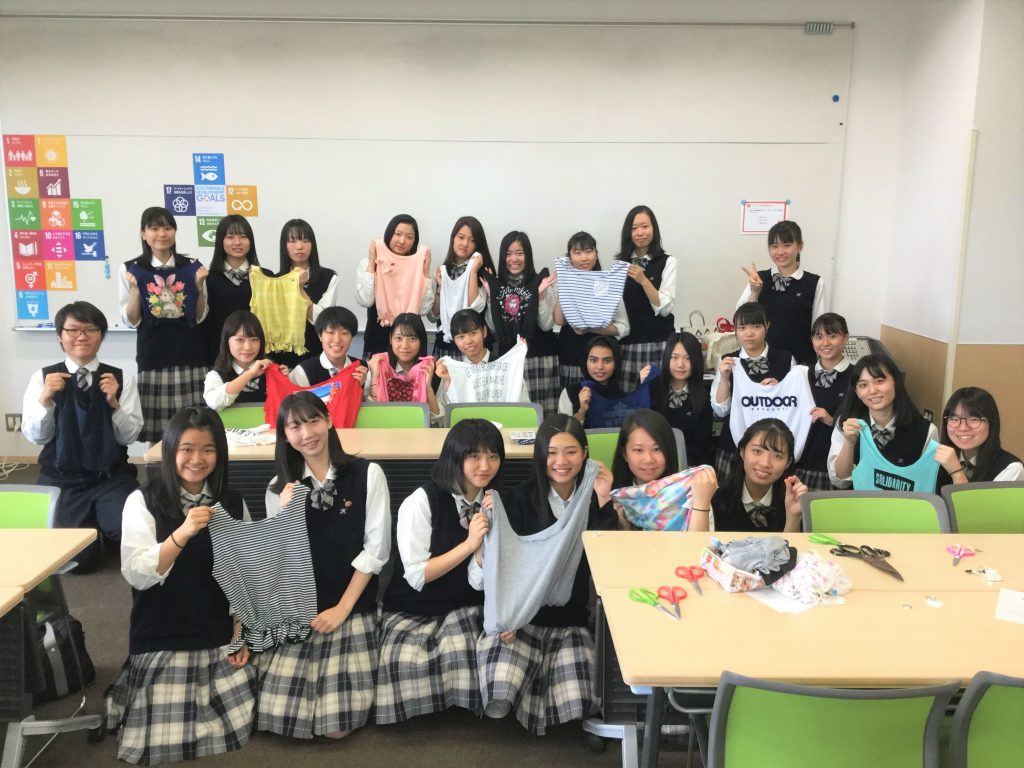実施日 : 2019年11月12日(火) - 13日(水)
SDGs Future City Toyama Press Tour
投稿日 : 2019年10月18日
SDGs Future City Toyama Press Tour
A Way for Cities to Thrive 20 and 30 Years in the Future
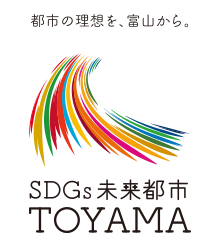 With regional cities throughout Japan facing issues including a declining birthrate, ageing population, population loss to Tokyo, and shrinking local economies, Toyama City has been pursuing a compact city policy for the past 15 years, looking forward 20 or 30 years with the goal of building a sustainable city. With new public transportation including Toyama Light Rail next-generation streetcars, the city has been engaged in initiatives to develop housing and commerce in the city center, as well as promoting reduced energy consumption, the use of renewable energy, and recycling waste products as an environmental city.
With regional cities throughout Japan facing issues including a declining birthrate, ageing population, population loss to Tokyo, and shrinking local economies, Toyama City has been pursuing a compact city policy for the past 15 years, looking forward 20 or 30 years with the goal of building a sustainable city. With new public transportation including Toyama Light Rail next-generation streetcars, the city has been engaged in initiatives to develop housing and commerce in the city center, as well as promoting reduced energy consumption, the use of renewable energy, and recycling waste products as an environmental city.
These initiatives have proven successful, and the number of people moving to Toyama City from outside the prefecture has surpassed the number of people moving to other prefectures for seven years in a row. The total fertility rate is also above the national average of 1.43, at 1.54, and Toyama City is continuing to grow as an active city. The city has also been chosen as a model compact city by the OECD (along with Melbourne, Paris, Portland, and Vancouver), as a model energy efficient city by the United Nations, and as one of the Rockefeller Foundations 100 Resilient Cities (the first Japanese city to be selected).
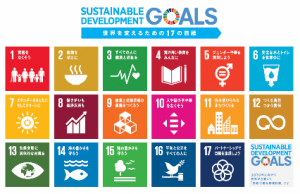 The Sustainable Development Goals were adopted in September 2015 at a UN summit, under the theme of “leaving no one behind.” They describe concrete goals which should be met by 2030. The Cabinet Office of Japan, with the reasoning that fulfilling the SDGs will help stimulate local economies, selected 29 cities throughout Japan as SDGs Future Cities in June 2018, including Toyama City, as cities carrying out initiatives to fulfil the SDGs. There are now 60 SDGs Future Cities. Toyama City was further selected as a SDGs Model City due to its initiatives being particularly advanced.
The Sustainable Development Goals were adopted in September 2015 at a UN summit, under the theme of “leaving no one behind.” They describe concrete goals which should be met by 2030. The Cabinet Office of Japan, with the reasoning that fulfilling the SDGs will help stimulate local economies, selected 29 cities throughout Japan as SDGs Future Cities in June 2018, including Toyama City, as cities carrying out initiatives to fulfil the SDGs. There are now 60 SDGs Future Cities. Toyama City was further selected as a SDGs Model City due to its initiatives being particularly advanced.
◆This tour will cover initiatives based on the Toyama City SDGs Future City Plan:
Creating a Sustainable Added-Value Creative City Through a Compact City Strategy.
The tour will see high school students working on the SDGs,
efforts to create a cyclical city through promoting food waste recycling and other measures,
initiatives to support raising children,
cooperation with local businesses to use renewable energy and electric vehicles,
and other unique and diverse businesses in Toyama City.
Toyama City Mayor, Mr. Masashi Mori (67)
 Born in Toyama City in 1952. Was first elected as mayor of the former Toyama City in 2002. After the city merged with six neighboring towns and villages in April 2005, he was elected as the first mayor of the new Toyama City, and is now in his fourth term. With population decline, a reduced birthrate, and an ageing population remaining as issues, the mayor has pursued initiatives to improve the city’s capabilities to build a sustainable city for the future, based on a core policy of creating a compact city with concentrated functions based around public transportation.
Born in Toyama City in 1952. Was first elected as mayor of the former Toyama City in 2002. After the city merged with six neighboring towns and villages in April 2005, he was elected as the first mayor of the new Toyama City, and is now in his fourth term. With population decline, a reduced birthrate, and an ageing population remaining as issues, the mayor has pursued initiatives to improve the city’s capabilities to build a sustainable city for the future, based on a core policy of creating a compact city with concentrated functions based around public transportation.
◆Mr. Mori will speak about the Toyama City SDGs Future City Plan, which aims to spiral up the initiatives which have been implemented so far.
1.Sustainable City Life and Disaster-Resistant Town Made Possible by Electric Vehicles
Toyama is second in Japan for the number of passenger vehicles per household. While improving public transportation and creating a compact city that does not require excessive reliance on cars, the city is also encouraging the adoption of electric vehicles which run on clean energy instead of gasoline, and disaster measures using them in the case of power outages, as part of regional disaster-prevention initiatives.
(1) Toyama Mitsubishi Motor Sales
Next-generation storefront to support the lives of residents in the case of disaster: Electric Drive Station
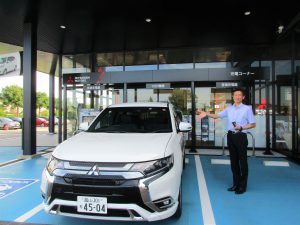 Mitsubishi Motors began development of environmentally-friendly electric vehicles fifty years ago, and in 2009 they announced the i-MiEV as "the pioneer that will open the door to the next 100 years." Mitsubishi’s goals are to contribute to a sustainable society and bring about a society where everyone can live comfortably. Vehicles which can run on electricity (electric and hybrid vehicles) are a valuable method of transportation after disasters, when gasoline becomes difficult to obtain. After the 2011 Great East Japan Earthquake, the Tokyo Electric Power Company lent out electric vehicles free of charge, which were used in affected areas. There are also devices (V2H: vehicle to home) so the car’s electricity can be used for household appliances such as microwaves and washing machines, making it possible to live a relatively normal life even during long-term power outages.
Mitsubishi Motors began development of environmentally-friendly electric vehicles fifty years ago, and in 2009 they announced the i-MiEV as "the pioneer that will open the door to the next 100 years." Mitsubishi’s goals are to contribute to a sustainable society and bring about a society where everyone can live comfortably. Vehicles which can run on electricity (electric and hybrid vehicles) are a valuable method of transportation after disasters, when gasoline becomes difficult to obtain. After the 2011 Great East Japan Earthquake, the Tokyo Electric Power Company lent out electric vehicles free of charge, which were used in affected areas. There are also devices (V2H: vehicle to home) so the car’s electricity can be used for household appliances such as microwaves and washing machines, making it possible to live a relatively normal life even during long-term power outages.
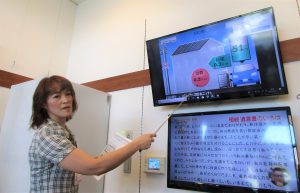
After the 2018 Hokkaido Eastern Iburi earthquake, a family that purchased an electric vehicle right before the earthquake commented that “We were saved by this extra lifeline.” At the Electric Drive Station, which opened in May 2019 at the Toyama Mitsubishi Motor Sales main store, it is hoped that in the case of disaster, local residents will go there and use electric vehicles to charge their smartphones, making it into a place to gather information.
◆The tour will hear about how vehicles are charged at the charging corner, and there will be a demonstration of how the external power supply of electric vehicles can be used after disasters at the lifestyle corner inside.
(2) Hokuriku Electric Power Company
Smart life combining electric vehicles, storage batteries, solar power, and EMS
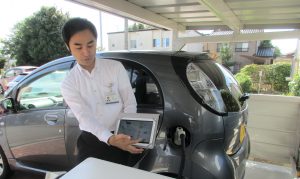 Since its establishment in 1951, Hokuriku Electric Power Company has contributed to the development of industry and protected the foundation of people’s lives in the area through electricity. The company made an agreement with the city to use environmentally-friendly energy and develop a sustainable transportation network, and is working on solving local challenges to create a safe and comfortable city.
Since its establishment in 1951, Hokuriku Electric Power Company has contributed to the development of industry and protected the foundation of people’s lives in the area through electricity. The company made an agreement with the city to use environmentally-friendly energy and develop a sustainable transportation network, and is working on solving local challenges to create a safe and comfortable city.
One of their initiatives is a proof of concept test of energy management at their company housing, which began in January 2019. The company housing has electric vehicles, storage batteries, and solar power, and electricity usage is tracked by an energy management system the company developed itself, with the goal of enabling a comfortable life while eliminating wasteful use of electricity. With solar power, storage batteries, and power from electric vehicles, they are also fully prepared for power outages in case of disaster. Due to the high ownership of vehicles per household in the Hokuriku region, it is expected that households will use multiple electric vehicles, and the three electric vehicles available at the company housing are used for car sharing by the residents there, to pick up children or buy groceries.
◆The tour will hear about how the energy management system works, and interview the family of employees living in the company housing where the proof of concept test is being carried out.
(3) Takeoka Jidosha Kogei
Toyama’s “handmade” electric minicar, supporting the lives of the elderly and people with disabilities
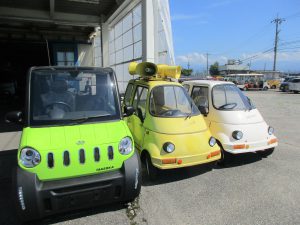 Founded in 1982, this factory produces minicars for which Toyama is known. Having started as a manufacturer of minicars for people with disabilities, the company now makes standard minicars as well. Takeoka Jidosha Kogei began joint development of an electric vehicle with Hokuriku Electric Power Company in 1996. They produce vehicles tailormade to individual lifestyles, such as an electric vehicle that people in wheelchairs can get in and out of while remaining in their wheelchair.
Founded in 1982, this factory produces minicars for which Toyama is known. Having started as a manufacturer of minicars for people with disabilities, the company now makes standard minicars as well. Takeoka Jidosha Kogei began joint development of an electric vehicle with Hokuriku Electric Power Company in 1996. They produce vehicles tailormade to individual lifestyles, such as an electric vehicle that people in wheelchairs can get in and out of while remaining in their wheelchair.
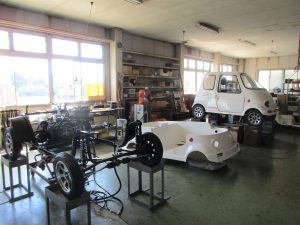 Electric minicars obviously produce no exhaust, but they also make almost no sound, can be charge in household 100V/200V outlets, and does not need to be registered under the automobile inspection system. With a maximum speed of 50 to 60 kilometers per hour, these cars have limited power and so seniors whose driving abilities may have decreased can feel safe using them to pick up groceries or go to work, making them invaluable as transportation allowing seniors to continue living free, active lives. Their newest electric vehicle, the LaLa Package 5, fulfills five functions at once: transportation, crime prevention, storage battery, power source, and power generation. At the age of 93, company founder Mr. Eiichi Takeoka continues to work on building cars as company president.
Electric minicars obviously produce no exhaust, but they also make almost no sound, can be charge in household 100V/200V outlets, and does not need to be registered under the automobile inspection system. With a maximum speed of 50 to 60 kilometers per hour, these cars have limited power and so seniors whose driving abilities may have decreased can feel safe using them to pick up groceries or go to work, making them invaluable as transportation allowing seniors to continue living free, active lives. Their newest electric vehicle, the LaLa Package 5, fulfills five functions at once: transportation, crime prevention, storage battery, power source, and power generation. At the age of 93, company founder Mr. Eiichi Takeoka continues to work on building cars as company president.
◆Executive director Mr. Manabu Takeoka will show the group around the factory. The tour will hear about making environmentally-friendly cars which meet the needs of the people using them.
2.Reduction of Food Loss and Plastic Waste
The Food Loss Prevention Promotion Act, with the goal of reducing “food loss,” when food which can still be eaten is thrown away, took effect this October. Currently in Japan, 6.34 million tons of food are thrown away annually (Ministry of Agriculture, Forestry, and Fisheries study, FY 2016). At the G7 Toyama Environment Ministers' Meeting in 2016, the Toyama Framework on Material Cycles, made with the goal of encouraging cyclical use of food and other materials as well as reducing the amount used, was adopted, and Toyama City is also one of the first places in Japan to implement an Eco Town Program with a zero emissions concept (a framework to use all the waste produced by industries as materials for different industries, thus reducing the waste produced to zero).
In 2008, Toyama was also first in Japan to announce plastic bags would stop being provided for free throughout the prefecture, and has carried out public awareness campaigns to reduce the amount of plastic waste since then. Currently, over 95% of people in Toyama bring their own bags to the store. The Ministry of the Environment used Toyama as a model when preparing for beginning to charge for plastic shopping bags throughout the country around summer next year.
(1) Eco Town: Toyama Green Food Recycle, Inc.
Working towards zero emissions: Turning food waste from grocery and convenience stores into resources
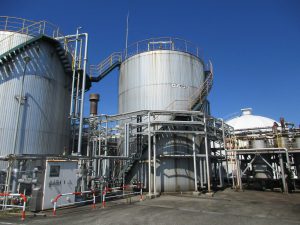 This recycling facility takes organic waste from convenience stores, grocery stores, hotels, food processing plants, and local households, using methane fermentation to produce biogas used as fuel or to generate electricity. The facility processes 30 to 35 tons of waste per day, producing 4000 cubic meters of biogas. The city currently collects household organic waste separately from other burnable garbage in 13 of the city’s districts, to be recycled at this facility. About two tons of organic waste can provide enough electricity for a family of four for one month. Some Lawson convenience stores in Toyama Prefecture also send food waste produced by their stores to be recycled.
This recycling facility takes organic waste from convenience stores, grocery stores, hotels, food processing plants, and local households, using methane fermentation to produce biogas used as fuel or to generate electricity. The facility processes 30 to 35 tons of waste per day, producing 4000 cubic meters of biogas. The city currently collects household organic waste separately from other burnable garbage in 13 of the city’s districts, to be recycled at this facility. About two tons of organic waste can provide enough electricity for a family of four for one month. Some Lawson convenience stores in Toyama Prefecture also send food waste produced by their stores to be recycled.
 The facility also mixes the fermentation waste liquid produced in the methane fermentation process with grass and wood clippings to make fertilizer, which it sells. Two years ago, they also became able to use some burnable plastics as fuel, which until then was just being incinerated, and so were able to reduce costs while further protecting the environment.
The facility also mixes the fermentation waste liquid produced in the methane fermentation process with grass and wood clippings to make fertilizer, which it sells. Two years ago, they also became able to use some burnable plastics as fuel, which until then was just being incinerated, and so were able to reduce costs while further protecting the environment.
◆Ms. Miyuki Kobatake of the The eco-town exchange promotion center will explain the Eco Town Program, while Toyama Green Food Recycle’s president Mr. Yoshinobu Yotsu will explain food recycling. Afterwards, Mr. Yotsu will provide a tour of the facility.
(2) Café Gokko: “Vegetable Scraps Dressing” Using Vegetables Fully
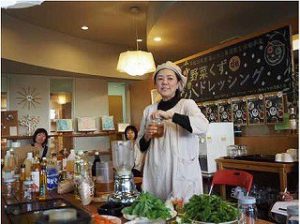 Café Gokko serves meals made using fresh, organic vegetables grown in Toyama. Owner Miyoko Hirono felt it was wasteful to throw away the cores and skins of the vegetables, which are full of flavor and nutrients, and so developed a homemade dressing using these vegetable scraps. She also runs cooking classes for locals. For the waste that is unavoidable, she composts and turns into fertilizer which she provides to farmers, making the restaurant part of a food cycle.
Café Gokko serves meals made using fresh, organic vegetables grown in Toyama. Owner Miyoko Hirono felt it was wasteful to throw away the cores and skins of the vegetables, which are full of flavor and nutrients, and so developed a homemade dressing using these vegetable scraps. She also runs cooking classes for locals. For the waste that is unavoidable, she composts and turns into fertilizer which she provides to farmers, making the restaurant part of a food cycle.
◆Ms. Hirono will speak about reducing food loss and running a food-cycle restaurant. The tour will then eat a lunch using local ingredients and the vegetable scraps dressing.
(3) Toyama University of International Studies High School
High school students helping Toyama City be a model city for plastic waste reduction
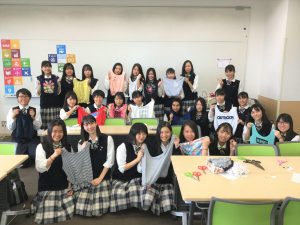 At the Climate Action Summit held at the UN Headquarters in New York this September, Greta Thunberg, a 16-year-old Swedish high school student, gave an impassioned speech on climate change to world leaders, which made headlines around the world. There are also high school students working to protect the environment in Toyama. In 2012, Toyama University of International Studies High School was the first school in the prefecture to become a UNESCO School, and it is working on educating future global leaders who can fulfill the SDGs. Below the panel listing the 17 SDGs located at the front entrance of the school, the school’s own goals are also listed, and SDG stickers are located throughout the school, as part of efforts to be aware of and work to fulfill the SDGs in daily life.
At the Climate Action Summit held at the UN Headquarters in New York this September, Greta Thunberg, a 16-year-old Swedish high school student, gave an impassioned speech on climate change to world leaders, which made headlines around the world. There are also high school students working to protect the environment in Toyama. In 2012, Toyama University of International Studies High School was the first school in the prefecture to become a UNESCO School, and it is working on educating future global leaders who can fulfill the SDGs. Below the panel listing the 17 SDGs located at the front entrance of the school, the school’s own goals are also listed, and SDG stickers are located throughout the school, as part of efforts to be aware of and work to fulfill the SDGs in daily life.
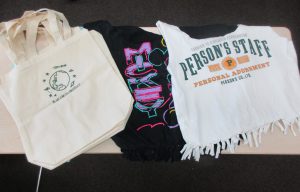 Most of these activities center around the school’s UNESCO Club, which was started in 2017. Having seen with their own eyes how plastic waste is threatening the continued existence of Toyama’s beautiful sea, the club started the Hokuriku Toyama Blue Earth Project to reduce plastic waste, carrying out various activities to support sustainability in the community such as a quiz rally and play targeting families at locations such as an aquarium, and making eco bags from old clothes. The members have also gone overseas, and worked together with high school students from China, Russia, and South Korea on environmental activities.
Most of these activities center around the school’s UNESCO Club, which was started in 2017. Having seen with their own eyes how plastic waste is threatening the continued existence of Toyama’s beautiful sea, the club started the Hokuriku Toyama Blue Earth Project to reduce plastic waste, carrying out various activities to support sustainability in the community such as a quiz rally and play targeting families at locations such as an aquarium, and making eco bags from old clothes. The members have also gone overseas, and worked together with high school students from China, Russia, and South Korea on environmental activities.
◆The tour will hear about activities by the students at the school, in particular the UNESCO Club, working towards fulfilling the SDGs.
*UNESCO Schools= Schools working to realize UNESCO’s ideals, through peaceful international cooperation.
3.Regional Support for Raising Children
With the trend towards nuclear families, weakening of community bonds, and increase in households where both parents work, the situation for raising children has changed significantly in recent years. Although the Japanese government has set a target for FY 2025 of a “desired birthrate” (the birthrate assuming everyone who wants to have children has as many as they want to) of 1.8, the current birthrate is only 1.43. Regional support to create an environment where people can feel they can have children if they want is an urgent issue. Toyama City opened the Toyama City Machinaka General Care Center in 2017, as a regional comprehensive care center that is part of the city’s efforts to ensure all residents, from infants to seniors and people with disabilities, can live safe, healthy lives. It includes the first childbirth and childcare support facility operated by a local government. With Toyama ranked third in the country for households where both parents work, the government is implementing unique policies to support raising children by working parents.
Japan’s First Childcare Support Facility Operated by a Local Government
Toyama City Machinaka General Care Center
 Postnatal Care Support
Postnatal Care Support
Midwives provide advice and care to new mothers, who struggle with issues such as how to breastfeed and worry over how to raise their first child, while also dealing with sudden changes in their own condition after giving birth. In addition to having five rooms that can be used for overnight stays or daycare, there is an infant care room to take care of children as their mothers rest, a counseling room providing care for the mothers, and a dining room which provides balanced meals.
◆The tour will hear from midwife Ms. Kumiko Honbu about how individual care plans are made to support mothers after birth, and how midwives provide support so people can raise children with a positive attitude.
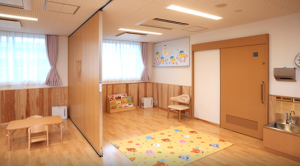 Daycare for Sick Children
Daycare for Sick Children
The city’s most unique initiative is the pickup service for the daycare for sick children. When a child becomes sick at daycare and a parent cannot go pick them up due to work or other reasons, a city nurse and childcare worker will pick up the sick child in a taxi, and after being checked by a primary care physician, the child will be taken to the Center’s daycare for sick children. The daycare will take in children six month’s old or older, up to ten per day, and for up to four kinds of illnesses at once. ◆Ms. Katsumi Morita, a nurse at this Center and specialist in care for sick children, was inspired to work here due to her own experience of raising a child while working at a university hospital, and will explain how the sick child daycare pickup service works. Ms. Honbu, who is a mother of three while also working as a midwife, will also speak from the perspective of someone who has used the facility.
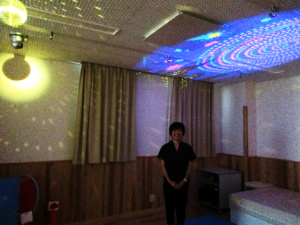 Child Development Support
Child Development Support
The child development support section offers continuing care from an early age for children which may have developmental difficulties, and their parents.
◆The tour will go to a Snoezelen room (relaxation room), which has sounds and vibrations that provide gentle stimulation said to lessen the symptoms of hyperactivity, and speak with counselor Ms. Kayo Matsubara.
4.A Small Global Company: Decorating Restaurants and Luxury Hotels Around the World with the Traditional Japanese Woodworking Technique of Kumiko
Tanihata Co., Ltd.
From rookies to veterans, 22 artisans creating a Japanese aesthetic
 Kumiko is a type of traditional Japanese woodworking technique originating in the Asuka period (592–700), in which thinly carved wooden pieces are assembled together without nails using precise technique. Tanihata Co., Ltd. was founded 60 years ago as a business using kumiko to create partitions for homes, with Toyama having one of the highest rates of home ownership in Japan. At the time, the demand for Japanese-style homes was so high their production could not keep up with it, but with the decline in popularity of Japanese-style rooms in the 1990s, demand plummeted. Although the company made various efforts, such as starting to make Western-style products, the increase in inexpensive foreign goods and veteran artisans leaving the business meant their sales remained in a slump.
Kumiko is a type of traditional Japanese woodworking technique originating in the Asuka period (592–700), in which thinly carved wooden pieces are assembled together without nails using precise technique. Tanihata Co., Ltd. was founded 60 years ago as a business using kumiko to create partitions for homes, with Toyama having one of the highest rates of home ownership in Japan. At the time, the demand for Japanese-style homes was so high their production could not keep up with it, but with the decline in popularity of Japanese-style rooms in the 1990s, demand plummeted. Although the company made various efforts, such as starting to make Western-style products, the increase in inexpensive foreign goods and veteran artisans leaving the business meant their sales remained in a slump.
 As the 2000s began, the company saw potential in internet sales, and in 2006 they renewed their company homepage after making the decision to return to Japanese-style products. Tanihata’s kumiko received attention from overseas for its refined technique, receiving various accolades such as a Bronze Award from the Design for Asia Awards (Hong Kong) and the iF Design Award 2017 Gold Medal (Germany). Currently, about 20% of the company’s orders come from North America, with their products being used in Japanese restaurants in Japan and abroad, as well as in other places such as the suite rooms of luxury hotels. In recent years, more young people have been seeking to join the company out of an interest in craftsmanship, and the staff ranges in age from 18 to the 72-year-old factory manager.
As the 2000s began, the company saw potential in internet sales, and in 2006 they renewed their company homepage after making the decision to return to Japanese-style products. Tanihata’s kumiko received attention from overseas for its refined technique, receiving various accolades such as a Bronze Award from the Design for Asia Awards (Hong Kong) and the iF Design Award 2017 Gold Medal (Germany). Currently, about 20% of the company’s orders come from North America, with their products being used in Japanese restaurants in Japan and abroad, as well as in other places such as the suite rooms of luxury hotels. In recent years, more young people have been seeking to join the company out of an interest in craftsmanship, and the staff ranges in age from 18 to the 72-year-old factory manager.
◆President Nobuo Tanihata will speak with the tour about traditional crafts, online sales, using Japanese wood without coating in their products, training younger workers as successors, and an employment style not bound by retirement age.


‐‐‐‐‐‐‐‐‐‐‐‐‐‐‐‐‐‐‐‐‐‐‐‐‐‐‐‐‐‐‐‐‐‐‐‐‐‐‐‐‐‐‐‐‐‐‐‐‐‐‐‐‐‐‐‐‐‐‐‐‐‐‐‐‐‐‐‐‐‐‐‐‐‐‐‐‐‐‐‐‐‐‐‐‐‐‐‐‐‐‐‐‐‐‐‐‐‐‐‐‐‐‐‐‐‐‐‐‐‐‐‐‐‐‐‐‐
[Tour Itinerary]
Schedule:
<Tuesday, November 12>
7:20-9:31 Tokyo Station to Toyama Station (Kagayaki 503)
9:45-10:00 Introduction on the bus
10:10-10:50 Hokuriku Electric Power Company
11:30-12:45 Takeoka Jidosha Kogei
13:00-13:50 Lunch on the bus
14:00-15:25 Toyama University of International Studies High School
16:30-18:00 Interview with Toyama City Mayor, Mr. Masashi Mori
18:30 Arrive at hotel
<Wednesday, November 13>
8:00 Leave hotel
8:45-10:00 Toyama Green Food Recycle, Inc.
10:45-12:10 Toyama City Machinaka General Care Center
12:25-13:25 Lunch at Café Gokko
13:45-15:00 Toyama Mitsubishi Motor Sales
15:30-17:00 Tanihata Co.,Ltd.
18:15 -20:23 Toyama station to Tokyo station (Kagayaki514)
- Qualification: Bearer of Gaimusho Press Registration Card
- Cost: 12,000 yen per person including transportation, accommodation (breakfast included), and lunches
*The following cancellation fees will apply:
-Cancellation before 3 p.m., Monday, Nov 11: 6,000 yen
-Cancellation after 3 p.m., Monday, Nov 11: 12,000 yen (full amount)
- Participants: Limited to 10 applicants. (Only one reporter or one photographer from each company, but two participants from each TV team will be acceptable.)
*If the number of applicants exceeds 10, an upper limit may be set on the number of participants from each country/region.
- FPCJ contacts: Megumi Ishida (Ms.), Mayuko Onishi (Ms.)
(Tel: 03-3501-3405, E-mail: ma@fpcjpn.or.jp )
- Remarks:
(1) This press tour is sponsored by Toyama City and Toyama Television Broadcasting, with planning cooperation by the FPCJ.
(2) Toyama Television Broadcasting will be making a program based on this tour, in order to show Toyama City residents how foreign media report on the city.
(3) The schedule is subject to change without notice.
(4) This tour will require participants to bear part of the cost, but is not a profit-making venture.
(5) Toyama City, Toyama Television Broadcasting and FPC will not be liable for any inconvenience, trouble or accident that might occur in the course of the tour.
(6) There may be some restrictions on photographing and filming at the tour sites. Please follow the instructions of the staff in charge.
(7) This press tour is intended to provide opportunities for news coverage.
We request that all participants send a copy of the content of their coverage (article, video, or audio in the case of radio) to the Toyama city through the FPCJ after their reports are published or aired. When your report is in a language other than English or Japanese, we also ask you provide a summary in English or Japanese. With receiving your application, we assume that you agree to these conditions.

